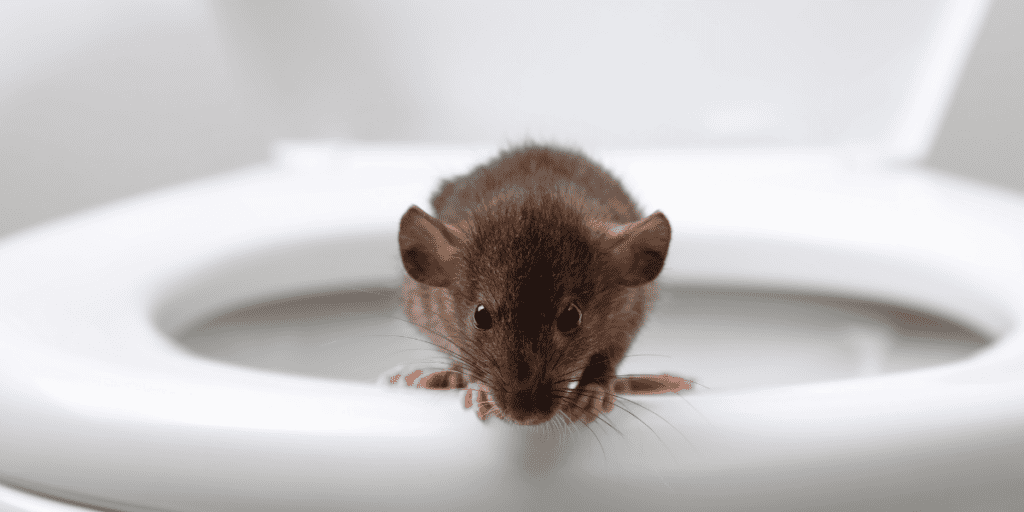Yes, rats are excellent swimmers, capable of swimming for long distances and surviving in water for several days. This post will explore their swimming abilities, including how they can enter homes through sewer lines and toilets. Understanding rats’ swimming skills is important for comprehensive pest control and prevention, especially in areas prone to flooding or with dense sewer systems.
POINTS
- Rats have physical adaptations such as powerful tails and water-resistant coats that make them proficient swimmers, capable of swimming for survival and navigating through tight spaces, including underwater.
- Rats can swim for extended periods, with some able to swim up to three days in extreme scenarios, and they can hold their breath for up to three minutes, which aids in their ability to travel through submerged pipes.
- Rats have the unsettling ability to navigate through plumbing systems and can appear in toilets, an occurrence that is more likely in densely populated urban areas with older sewer systems.
- Preventative measures for homeowners to avoid rat invasions include installing one-way valves in waste pipes, regular plumbing maintenance, and sealing any openings that could provide rats access to plumbing systems.
- Rats can cover significant distances while swimming, up to half a mile or more, which contributes to their spread as pests and invasive species, potentially impacting local ecosystems and necessitating effective pest control measures.
Do Rats Swim?
Rats are often associated with being pests, but their abilities extend far beyond scurrying around in the shadows. One of the most surprising capabilities of these rodents is their adeptness at swimming.
Rats have several physical adaptations that make them proficient swimmers. Their long, powerful tails act as rudders, helping them steer through water, while their flexible bodies allow them to wriggle through tight spaces. Their limbs are also well-suited for paddling, and they have a water-resistant coat that provides buoyancy and insulation.
Swimming for Survival vs. Recreational Swimming
Rats primarily swim out of necessity rather than for leisure. In the wild, swimming enables them to escape predators, search for food, or find new habitats. Urban rats, on the other hand, might swim through water to navigate the sewers or cross bodies of water to exploit new resources. While rats do not seek out water for recreation, they are capable of doing so if the situation calls for it.
Rats’ Underwater Capabilities
Rats have impressive underwater capabilities. They can hold their breath for up to three minutes, which allows them to travel through submerged pipes or escape flooding. Their ability to navigate while submerged is attributed to their sensitive whiskers, which help them detect changes in water currents and navigate around obstacles, even in complete darkness.
How Long Can Rats Swim?
Rats are not just quick dips in the pool; they possess remarkable stamina when it comes to swimming. They can swim for up to three days in extreme scenarios, though this is not common behavior. This endurance is part of what makes them such resilient survivors, capable of thriving in various environments.
Factors Affecting Rats’ Swimming Duration
Several factors influence how long a rat can swim or stay submerged. These include water temperature, the rat’s health and age, and the presence of predators or other stressors. Cooler water temperatures can reduce a rat’s stamina, while warmer waters may allow them to swim longer. Younger, healthier rats are typically better swimmers than older or weaker ones.
Can Rats Swim Up Toilets?

One of the more unsettling abilities of rats is their capacity to navigate through plumbing systems, which can lead to them surfacing in toilets. Rats can squeeze their bodies through tight spaces and are strong swimmers, enabling them to travel against the flow of water in sewer lines.
Frequency of Rats in Toilets
While it’s not an everyday occurrence, rats appearing in toilets is a phenomenon that has been documented, particularly in densely populated urban areas with older sewer systems. The frequency of these events can vary based on factors such as the condition of the plumbing and the rat population in the area.
Prevention Measures for Homeowners
To prevent rats from making an unwelcome appearance in your toilet, consider the following practical measures:
- Install a one-way valve in your toilet’s waste pipe, which allows waste to exit but prevents rats from entering.
- Regularly check and maintain your plumbing system to ensure there are no cracks or openings that rats can exploit.
- Seal any external openings or vents that could provide rats with access to your home’s plumbing.
Do Rats Like to Swim?
While rats are capable swimmers, whether or not they enjoy swimming is a matter of context. In the wild, rats may swim out of necessity rather than pleasure. However, pet rats have been known to take to water quite readily, suggesting that, under the right circumstances, rats may indeed find swimming to be an enjoyable activity.
How Far Can Rats Swim?
Rats are not only capable swimmers but can also cover considerable distances in water. They have been known to swim up to half a mile across open water, and even further in a current that supports their movement. This ability to traverse long distances is particularly concerning when considering the spread of rats as pests and invasive species.
Implications for Ecosystems and Pest Control
The swimming prowess of rats allows them to colonize new areas with ease, making them a challenging pest to control. They can cross rivers, canals, and even small stretches of sea to infest new territories. This capability also poses a threat to native wildlife, as rats can be aggressive competitors for food and habitat, and may carry diseases that affect other species.
How Often Do Rats Come Up Toilets?
The occurrence of rats in toilets is a disturbing thought for many homeowners, but it’s less common than one might fear. Most rats that enter homes through toilets are seeking shelter or have been flushed out of their sewer habitats by heavy rains or flooding.
Environmental and Structural Influences
The likelihood of a rat finding its way into your toilet depends on several factors:
- Sewer System Design: Older sewer systems with less sophisticated designs are more prone to rat invasions.
- Population Density: High rat populations increase the chances of encounters with these rodents, including in your plumbing.
- Home Maintenance: Homes with poorly maintained waste pipes are more vulnerable to unwanted visitors.
Can Rats Climb?
Yes, rats are highly adept climbers and can scale various surfaces, including vertical walls, pipes, and trees. Their sharp claws and agile bodies enable them to navigate and balance on narrow ledges and climb through complex structures. A rat’s climbing ability is an integral part of their survival, allowing them to escape predators, explore food sources, and find shelter in elevated areas. Rats can even climb inside the walls of buildings by gripping onto wiring and plumbing, making their way through different levels of a structure.



